
Volume XV, Issue XXIV
Glimpses into a World Unseen
The Amazing Photography of Alexey Kljatov
© 2018 The Kirchman Studio, All rights reserved.
Photographs © Alexey Kljatov, Used by permission.
When I first saw the work of Alexey Kljatov, I was amazed. He takes these stunning images with a simple point and shoot camera rigged with an old macro lens and employing skillful manipulation of lighting. Snowflakes landing on his Moscow window reveal their full wonder and individual beauty through his sublime images. Mr. Kljatov graciously allowed THYME to share his amazing work. You can see more of his photography Here [click to view].
Just imagine the swirling dance of these beautiful shapes in a snowstorm!






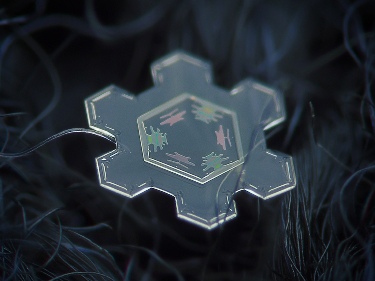





Glimpses into a World Unseen
Act II
The electron microscope further reveals amazing patterns.

Vertical section of the human dna.
Evidence of Divine Design, Great and Small
"The Heavens Declare the Glory of G-d;
The Skies Proclaim the Work of His Hands." -- Psalm 19:1

Moth wing pattern.
I saw this little creature outside my studio one morning. It got me reflecting on the creative wonder, both large and small, that surround us.
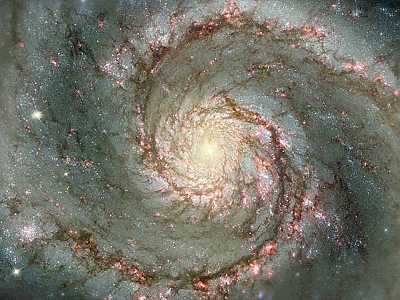
M 51 Spiral Galaxy, NASA photo from the Hubble Space Telescope.

Detail of the 'X Structure' in M 51, NASA photo from the Hubble Space Telescope.
The artist is amazed. So much beauty and wonder in the very large cosmos and in the very small things as well! Can a G-d who spins galaxies into being be concerned with things small and personal? Such order and grace in the extreme scales of our world, yet often what we see before us is chaotic and makes no sense.
That is why we present here Lee Strobel's Case for Faith and Case for Christ. If you had stepped into that Bethlehem stable many years ago, you would have not necessarily seen beauty and redemption. The smells of animals and the pain of labor and delivery would have overwhelmed contemplation. Yet Christians around the world will contemplate the wonder of that night; for what happened there ultimately made its mark on human history.
The Case for a Creator [click to view] by Lee Strobel
The Case for Faith [click to view] by Lee Strobel
The Case for Christ [click to view] by Lee Strobel
Who is Jesus?
Creche at the National Cathedral
A Particularly Beautiful Representation of the Nativity
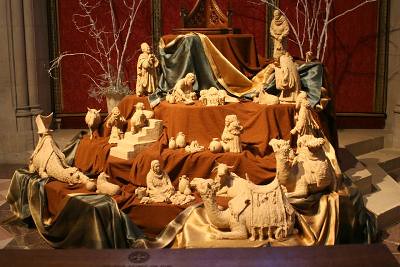
Photo by Kristina Elaine Greer.
Cville Frameworx
A Community Canvas
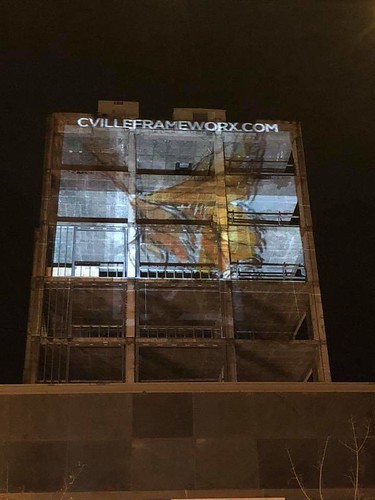
The partially finished Landmark Hotel in Charlottesville, Virginia becomes a 'community canvas' for projected art. Here is my image of a Migrating Monarch. CvilleFrameworx photo.
FRAMEWORX | Community Canvas is a digital art installation on the Charlottesville downtown mall that will showcase community contributed artworks on the abandoned Landmark Hotel. We’re creating an opportunity to use the Landmark Hotel as an epic gallery for community expression. The community’s collective works will serve to entertain, inspire and illuminate our cityscape.
FRAMEWORX | Community Canvas is a projection mapping installation that will warp and wrap the Landmark with projected imagery creating a visible, usable canvas out of the building’s concrete shell. Community art will be shared in a continuous loop on a regular schedule throughout the Holiday season, launching Saturday, December 1st at dusk. Submit your artwork now! Submit artwork at www.cvilleframeworx.com [click to visit].
The exhibit will feature original structure mapping art by Jeff Dobrow (aka Doc Jim) in addition to art submitted by the community.
The general public, schools, churches and any/all community groups are welcome and encouraged to submit digital photos for inclusion in the exhibit through the FRAMEWORX website and FB page. This is about fun, sharing and the creative expression of our community!
The Real Wonderful Life
Frank Capra's Life and Message
The W. J. Carpenter Company
Brightwood, Virginia

A W. J. Carpenter Chicken Coop.

Factory workers in an undated photograph.
Here is a bit of my family history and the story of some innovative Germans in Madison County, Virginia. Stories from Delma Rae Carpenter Jr. [click to listen]
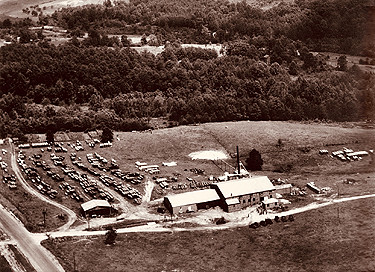
Aerial view of the factory.
Autumn Drive

Photo by Sandra Barlow Powell
Astound the Age
Michel Dufrénoy's Guide to Our Past Century
By Bob Kirchman
Copyright © 2018, The Kirchman Studio, all rights reserved
Chapter Seven
Jean Dumont stepped off the airship in Montréal and greeted Michel Dufrénoy warmly. “I’ve just a few hours before I must catch my train Westward,” he said, “but I am so glad we could at least spend an evening together for old time’s sake.” Dumont’s wife and children would come later after he had established himself in his new position. “The Northwest Corridor Corporation will eventually connect America to Asia,” Jean continued. “You would do well to come with me to that place where opportunity is in such abundance. I could get you on as a clerk in our Calgory office. The great road to Alaska is already in place but we are widening it to a primary route with multiple travel paths just like our autoroutes in Paris. Astounding things are being done and you and your Lucy can have all the success you desire!”
Dufrénoy quizzed his former colleague relentlessly over dinner about the works in Western Canada. Dumont provided an extremely detailed description, adding: “There are untouched regions out there. It’s a chance to literally build a whole new world!” Dufrénoy pondered that statement gravely: “You mean, one would be able to create the culture from the ground up?” “Exactly,” said Jean, “There will be no relics of the past to impede the progress of mankind to that ‘great big beautiful tomorrow!’ Think of it, Michel, a clean slate on which to chart the future into the 21st Century! Antiquated notions no longer will restrain us. It will be a brave new world!”
There is NOTHING in those lands?” Dufrénoy asked, somewhat amazed. “Oh, there are some small farming communities, the local indigenous people and some old Russian Orthodox communities, but they are small and isolated. I imagine when our great corridor is laid out they will remain small and isolated. When the United States built the first gravel track along the route to Alaska, the local natives had never even seen a white man – Europeans were so completely unknown to them. The United States sent a group of Southern soldiers to build the road in the remotest part of that territory. They were the descendants of Africans who had been sold into slavery in that part of the world a Century ago – now free, but still lacking stature in that society. Their 97th Construction Battalion gave them purpose, and eventually stature as they built that most difficult section of the road.” [1.]
Dumont went on to say that the natives had heard reports that the white men were coming building the road. When one of the advance men for the 97th came into that region, a stunned native announced; “The first white man I saw was BLACK!” Jean went on: “The road was built in the days when Russia and America were still strong adversaries. In our day it is seen more as a way to connect those two peoples.”
Chapter Eight
Dufrénoy pondered the possibilities of true frontier and thought long and hard about the opportunity to fund the community’s relocation into someplace like the Yukon Territory where culture would actually be quite content to leave them alone. The men of the 97th had happily returned to warmer climes when the road was opened. One of them was Nehemiah Atkinson, who returned to New Orleans in Louisiana and became a tennis instructor to young people. [2.] Michel came across a small biography of this man. Indeed it seemed that this Northwestern country offered great opportunity for achievement and recognition, but most who came here wanted simply to do the job and go home.
Thousands of miles of vast wasteland, yet those few who lived there would not be moved. Amish folk were able to farm there, making the most of the short growing season. These were people from a simpler time it seemed, content to live a simpler way of life. If asked, they would cite their religious beliefs or their tie to a particular place. Some of their children did indeed go off to the big cities – but it was to be noted that many of them later returned. Such was the draw of warm pre-industrial society and extended family.
The more he thought about it, the more it became clear to Michel that this great road would always remain a conduit, but would not allow modern culture to spread out much past the required service areas. The Orthodox villages seemed especially appealing, as the very term ‘Orthodox’ seemed to imply that some foundation of the old culture would always be present. “What better place,” thought Dufrénoy, “to preserve and encourage the arts until they are strong enough to inform the culture again?”
And when the arts have rejuvenated themselves,” his mind continued, “the modern highways will be there to carry the renaissance to the ends of the earth!”
Chapter Nine
So it was that Michel Dufrénoy found himself traveling to Calgory along with several of the men of the community to take up work in the Northwest Corridor. The men would work and establish the means to bring the rest of their fellows and families West to a place they would find to settle in. The country they rode through seemed so vast and beautiful that it filled young Dufrénoy with its promise! He thought of the New York Fair and shuddered. It was amazing in its own way but in retrospect it seemed like when children place household items out on the floor in play to create a village. It is interesting but is heavy on large forms and lacks in subtle detailing. It is astounding to behold, but over time it does not evoke a higher appreciation.
Here in the American West, there arose a landscape that never ceased to inspire wonder. It seemed so vast as to resist the forces that had homogenized the great cultures of the world. In it the locomotive seemed small, the track but a line, and man was once more aware that there was more! It was that sense of more, Dufrénoy reasoned, that had informed culture in the past to seek the essence of truth and beauty. In modern thought, materialism and pragmatic utilitarianism ruled, but here in the limitless West, those things were not enough. The march of shadows in setting sun drowned out the songs of pistons and turbines. Here was a world too vast to comprehend coming into being.
The ancients had their cosmology firmly rooted in EX NIHILO Creation – the belief that the Divine had created everything from nothing! That implied that the stuff of creation, the laws of physics, and the creation itself were the product of some beautiful Divine Design. The moderns had in the end of the Nineteenth Century decided that they would only believe in what they could see. “Matter,” they said, “always must have existed and just formed itself through random processes.” Though science described the processes, the scientist no longer saw the sublime nature of the process. Another concept thrown to the wind was the concept of IMAGO DEI, that is the belief that mankind is created in the image of the Divine.
Thus it was that Michel Dufrénoy found himself fleeing a world where man was reduced to a cog – to a world where man was indeed heir to something better. His letters to Lucy were full of such thoughts and she cherished the seed that they planted. Together they would give their children everything that had been thought lost.
THE END
Remembering a Special Day
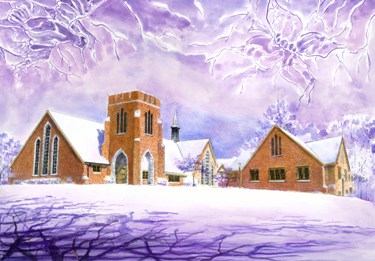
Winter scene, St. John's United Methodist Church in Staunton, Virginia. The painting celebrates the wedding of Kristina Elaine and Jonathan Greer four years ago! Happy Anniversary!
Painting by Bob Kirchman.
